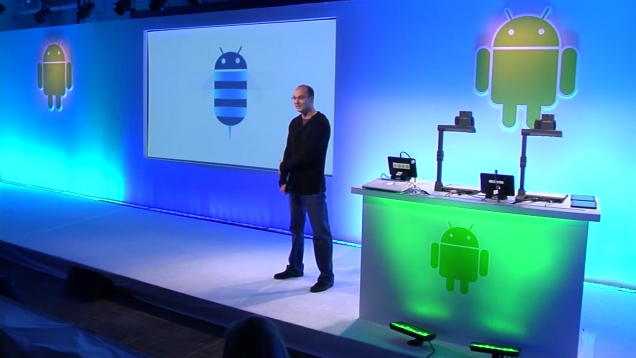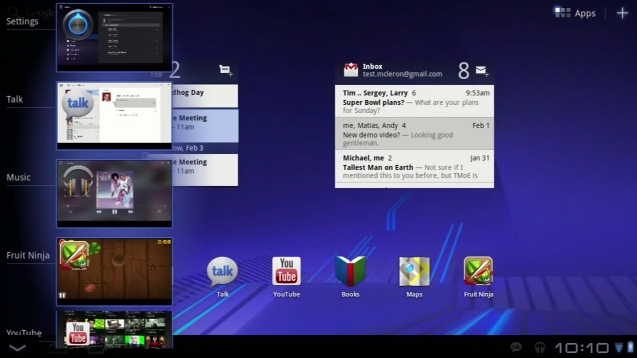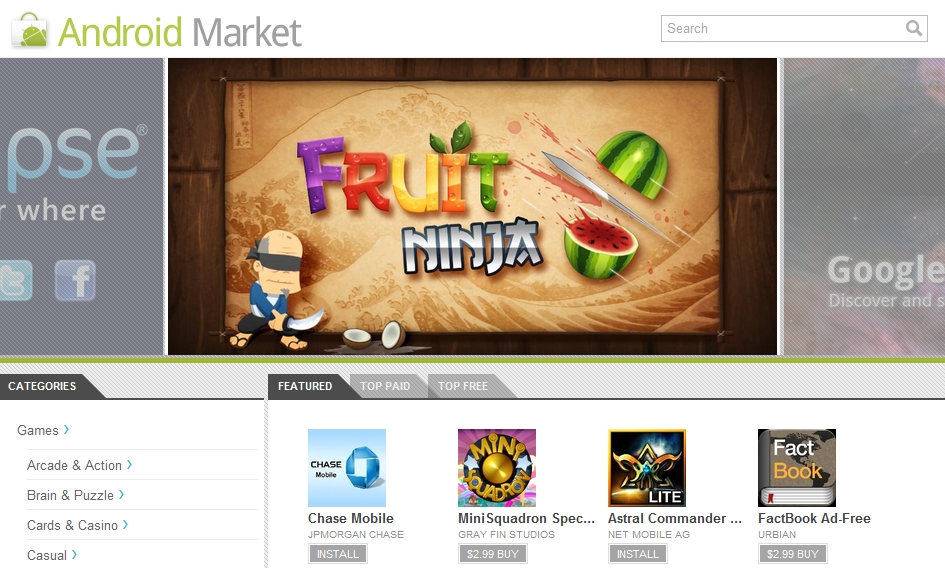
This week Google held a brief Android-themed event where they highlighted elements of the tablet-specific Honeycomb UI, introduced the Android Market Web Store, and previewed Android Market in-app purchasing. Hop after the break for all the details.

Honeycomb: Android 3.0 (aka Honeycomb) is “built entirely for tablet”, but we knew that already. A series of videos uploaded to YouTube by hardware manufacturers last month revealed many of the slick UI updates, but Google deemed it necessary to highlight specific parts of the open-source mobile OS under their own terms. At the event, Google first gave a brief tour of the redesigned home screen. The bottom left of the screen features back, home, and multitasking icons. When the multitasking button is tapped, it brings up a pane showing full previews of running applications; these in turn can be tapped to resume work/play. The bottom right of the screen is where unobtrusive notifications will alert you, music player controls pop up on command, and there’s quick access to settings like airplane mode, WiFi, lock screen orientation, brightness, and notifications on/off. In the center of the screen you can easily interact with and organize widgets.
In addition to these UI elements, Google also highlighted OS improvements of import. For example, Honeycomb brings with it 2D and 3D hardware acceleration, a new animation framework, and a new graphics engine called Renderscript that provides for high performance interactive 3D graphics. The following apps were briefly opened to demonstrate these improvements: YouTube (features a 3D video wall), Books (features a 3D carousel for browsing and smooth page turning), Maps (constructs 3D buildings), Music (carousel-like browsing), and Google Body (described as “the Google Maps of anatomy). Google also described what they’re calling “application fragments” for tablet-optimized apps. In Gmail, for example, various panes, or fragments, can be transitioned from one place to another depending on the device’s orientation. Lastly, the new and improved Camera app can access a front-facing camera which can support video chat. At the event, Google managed to successfully initiate a video chat with Cee-Lo Green over WiFi (though keep in mind video chat will also work over 3G/4G cellular networks).
Google introduced two app developers to the stage to demonstrate how they will take advantage of Honeycomb’s new features. Wardrum Studios showed off two games, a hack and slash shooter called Monster Madness and an educational strategy game Great Battles Medieval. These games are graphics intensive and use dual cores to run at top speeds. They are expected to hit the Android Market within the next month. Next CNN took the stage to show off its CNN app made specifically with Android’s UI elements in mind, including “fragments.” The app features live streaming video as well as CNN’s iReport functionality. With it, users can capture pictures and video using a Honeycomb tablet’s back or front-facing camera and upload their eyewitness news reports straight to CNN’s servers to share with the world. It’s coming soon to the Android Market for free. Note: existing Android apps built for mobile phones will run just fine on Honeycomb; Fruit Ninja was demoed and it ran without a hitch.

Android Market: After hyping Honeycomb, Google transitioned to the Android Market. Specifically, they formally introduced the Android Market Web Store. Those who own an Android device can now access, browse, and download Android apps directly from the web inside a browser. In other words, the Android Market from the phone has been ported to the web. The interface is familiar: at the top there’s a carousel of apps to click through, below that there are featured, top paid, and top free tabs, and to the left there’s app Categories to browse. When you click an app you’ll be brought to an applications detail page. Devs can upload high resolution images, large icons, a description, screenshots, and YouTube videos to their app page. User reviews are here, too. Additionally, developers can highlight a “more from developer” pane to promote other apps made by them. Users will also find a Twitter button which allows them to send links to their friends; these links will direct others directly to the app detail page. The Market can be accessed here: market.android.com.
Now here’s something to get excited about. The Android Market Web Store supports over-the-air transfer of apps. For example, when you click the buy button and purchase an app, said app will automagically be sent to your phone, download and install itself on it–no questions asked. Within seconds your phone will notify you that the app is being installed. No wires, nothing–take that Apple! How does it work? Simple. All you have to do is attached a credit card to your Google account (if you haven’t done so already) and register your Android device(s) to the account. Inside the My Account page (in the Web Store) you’ll find a list of all your installed apps, as well as a way to nickname individual registered devices to make them easily recognizable (i.e. you might own a Nexus S and a Motorola Xoom and want to distinguish them to your liking).
Next up: support for in-app purchases is coming soon! Apple’s apps have had this for some time now, and Google is ready to take a crack at it. Come this spring, devs will have the option to sell virtual goods from within their apps. For example, Disney will be able to sell track packs within Tap Tap Revolution 4 (which is finally coming to the Android platform prior to the end of this quarter along with Radio Disney and JellyCar).
Other notable Android Market updates… The Web Store features improved search options (sort by app popularity, compatible devices, etc.); and buyer currency support. The latter update will allow international developers to provide explicit prices for various currencies. Devs can still let automatic conversions do its thing, Google is only giving them the option to remove this minor headache from consumers. New currencies will roll out over the next few months, Google promises.
And that about does it. With Apple leading the way in tablet sales and app development support, Google is willing and ready to stomp all over their wild success. The Android Market is now available in more places than one, and in-app purchases will soon open up new doors for developers to further monetize their apps. What’s most exciting, however, is the next generation of Android. With the release of Motorola’s Xoom tablet later this month, the iPad will meet its match in Honeycomb. If you’ve been holding out for an iPad 2, your options just expanded.
In related Google news… Chrome 9 has been released into wild and with it comes support for WebGL (hardware-accelerated 3D graphics), Chrome Instant (Google Instant brought to the omnibox), and the Chrome Web Store (which is now open to all Chrome users in the US). Chrome should automatically update itself to the latest build assuming you’ve closed it recently.
Watch the Google Android event described above in its entirety right here: